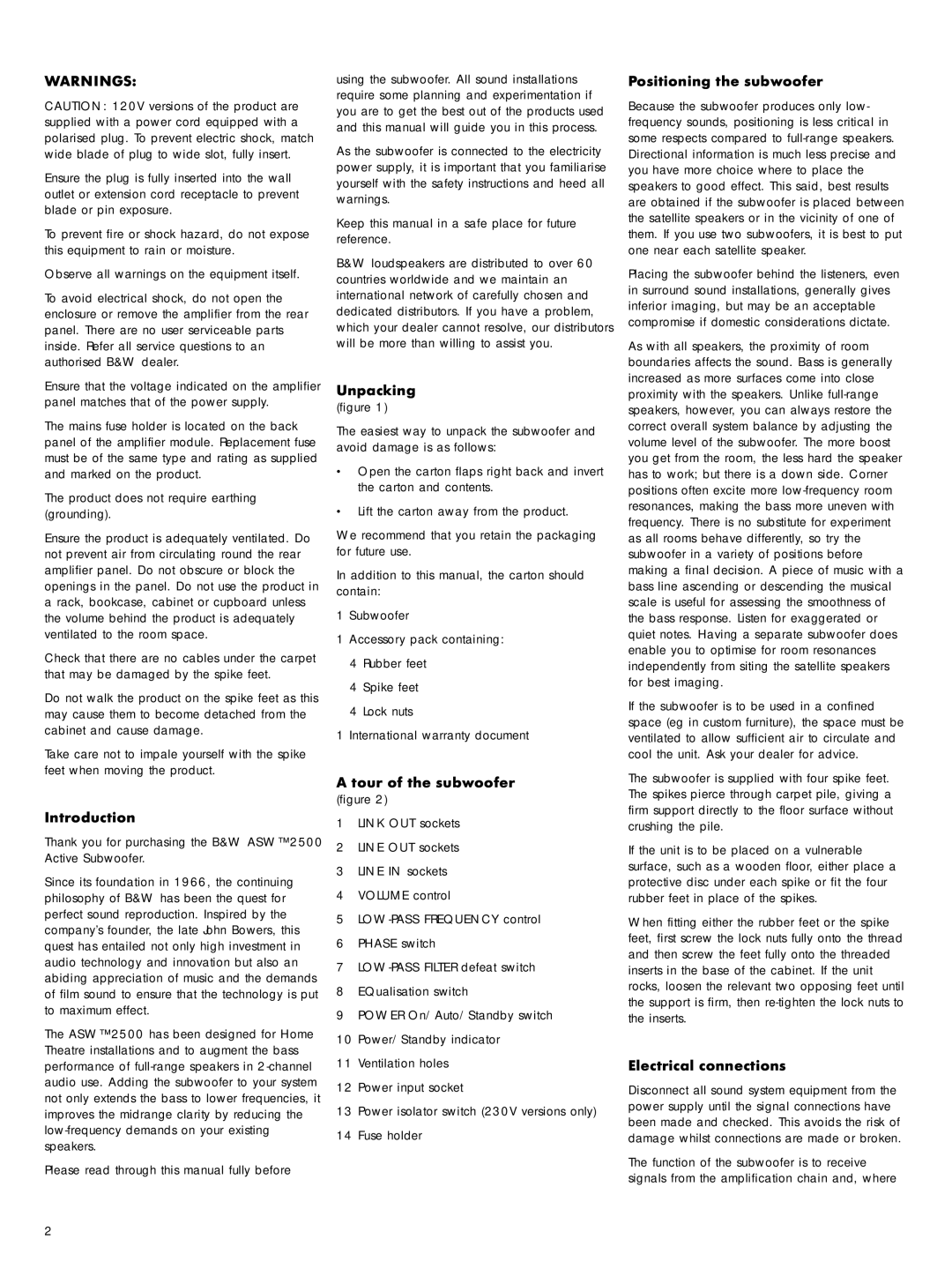WARNINGS:
CAUTION: 120V versions of the product are supplied with a power cord equipped with a polarised plug. To prevent electric shock, match wide blade of plug to wide slot, fully insert.
Ensure the plug is fully inserted into the wall outlet or extension cord receptacle to prevent blade or pin exposure.
To prevent fire or shock hazard, do not expose this equipment to rain or moisture.
Observe all warnings on the equipment itself.
To avoid electrical shock, do not open the enclosure or remove the amplifier from the rear panel. There are no user serviceable parts inside. Refer all service questions to an authorised B&W dealer.
Ensure that the voltage indicated on the amplifier panel matches that of the power supply.
The mains fuse holder is located on the back panel of the amplifier module. Replacement fuse must be of the same type and rating as supplied and marked on the product.
The product does not require earthing (grounding).
Ensure the product is adequately ventilated. Do not prevent air from circulating round the rear amplifier panel. Do not obscure or block the openings in the panel. Do not use the product in a rack, bookcase, cabinet or cupboard unless the volume behind the product is adequately ventilated to the room space.
Check that there are no cables under the carpet that may be damaged by the spike feet.
Do not walk the product on the spike feet as this may cause them to become detached from the cabinet and cause damage.
Take care not to impale yourself with the spike feet when moving the product.
Introduction
Thank you for purchasing the B&W ASW™2500 Active Subwoofer.
Since its foundation in 1966, the continuing philosophy of B&W has been the quest for perfect sound reproduction. Inspired by the company’s founder, the late John Bowers, this quest has entailed not only high investment in audio technology and innovation but also an abiding appreciation of music and the demands of film sound to ensure that the technology is put to maximum effect.
The ASW™2500 has been designed for Home Theatre installations and to augment the bass performance of
Please read through this manual fully before
using the subwoofer. All sound installations require some planning and experimentation if you are to get the best out of the products used and this manual will guide you in this process.
As the subwoofer is connected to the electricity power supply, it is important that you familiarise yourself with the safety instructions and heed all warnings.
Keep this manual in a safe place for future reference.
B&W loudspeakers are distributed to over 60 countries worldwide and we maintain an international network of carefully chosen and dedicated distributors. If you have a problem, which your dealer cannot resolve, our distributors will be more than willing to assist you.
Unpacking
(figure 1)
The easiest way to unpack the subwoofer and avoid damage is as follows:
•Open the carton flaps right back and invert the carton and contents.
•Lift the carton away from the product.
We recommend that you retain the packaging for future use.
In addition to this manual, the carton should contain:
1 Subwoofer
1 Accessory pack containing:
4 Rubber feet
4 Spike feet
4 Lock nuts
1 International warranty document
A tour of the subwoofer
(figure 2)
1LINK OUT sockets
2LINE OUT sockets
3LINE IN sockets
4VOLUME control
5
6PHASE switch
7
8EQualisation switch
9POWER On/Auto/Standby switch
10Power/Standby indicator
11Ventilation holes
12Power input socket
13Power isolator switch (230V versions only)
14Fuse holder
Positioning the subwoofer
Because the subwoofer produces only low- frequency sounds, positioning is less critical in some respects compared to
Placing the subwoofer behind the listeners, even in surround sound installations, generally gives inferior imaging, but may be an acceptable compromise if domestic considerations dictate.
As with all speakers, the proximity of room boundaries affects the sound. Bass is generally increased as more surfaces come into close proximity with the speakers. Unlike
If the subwoofer is to be used in a confined space (eg in custom furniture), the space must be ventilated to allow sufficient air to circulate and cool the unit. Ask your dealer for advice.
The subwoofer is supplied with four spike feet. The spikes pierce through carpet pile, giving a firm support directly to the floor surface without crushing the pile.
If the unit is to be placed on a vulnerable surface, such as a wooden floor, either place a protective disc under each spike or fit the four rubber feet in place of the spikes.
When fitting either the rubber feet or the spike feet, first screw the lock nuts fully onto the thread and then screw the feet fully onto the threaded inserts in the base of the cabinet. If the unit rocks, loosen the relevant two opposing feet until the support is firm, then
Electrical connections
Disconnect all sound system equipment from the power supply until the signal connections have been made and checked. This avoids the risk of damage whilst connections are made or broken.
The function of the subwoofer is to receive signals from the amplification chain and, where
2
